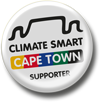Climate Smart Cape Town Pavilion wins at COP17
The Climate Smart Cape Town Pavilion at COP17 has won the best outdoor and best overall stand in the Climate Change Response Expo. The Pavilion, constructed out of 1884 plastic milk crates and over 22,000 plastic milk bottles supplied by Polyoak Packaging, is a temporary structure that has a low-impact on the environment as it will be dismantled after the climate change conference in Durban and all the materials re-used.
Using different coloured crates to create the outline of Table Mountain, with Lion’s Head and Devil’s Peak, the Pavilion is an iconic design that showcases the vision and the projects that will enable Cape Town to become a lower carbon city adapting well to the impacts of climate change, protecting its most vulnerable citizens and building an economic future based on clean development, localisation and jobs for all.
We would like to specially thank Polyoak Packaging for generously sponsoring all of the plastic milk crates and plastic milk bottles used in the construction of the Pavilion.
Inside the Pavilion, 22 large format posters containing text, graphics and photographs, highlight the fact that in looking for solutions, City of Cape Town officials and the Western Cape are being stretched by increasing climate change impacts and the need for novel ways of managing urban spaces and the growing number of people that occupy them. Topics that are covered in the posters and in DVDs screened, range from the policies and plans that will facilitate positive change in Cape Town and deal with the challenges and complexities of global warming to targets to reduce electricity consumption by 10%, as well as how Cape Town plans to be a leading low-carbon city, with 10% of its energy supply drawn from cleaner energy sources by 2020.
Commenting on the Climate Smart Cape Town Pavilion at COP17, the City’s Mayoral Committee Member for Economic, Environmental and Spatial Planning, Alderman Belinda Walker, stated that the City and its coalition partners required an exhibition that would convey the message of climate change actions in the city in the most responsible way.
“COP17 in Durban will place global environmental issues such as climate change under a spotlight, and is an opportunity for Cape Town to promote pro-active approaches to these issues among local and international audiences. We wanted to create an exhibition structure that would look different from all the other tented structures at the Climate Response Expo in Durban. The proposal that we received from Stephen Lamb of Touching the Earth Lightly and ST&AR Architects responded to our needs in that it was to be made entirely from recycled and re-usable materials so as to produce zero waste after dismantling. In addition, all construction materials were to be sourced within the tightest possible radius of the site to minimise the carbon footprint”, Alderman Walker said.
Says Andre Rademeyer of ST&AR Architects; “The recyclable milk crates and milk bottles are tied to a rectangular 15 x 12m scaffolding frame. They act as ‘cells’ with excellent thermal heat and cooling qualities. Low energy lighting behind the crates illuminates the entire structure at night turning it into a glowing ‘jewel box’ promoting sustainability. The interior contrasts with the exterior, being clad entirely in alien timber from trees pruned and felled by Working for Water. The interior is lit from above with translucent roof panels allowing sufficient light into the Pavilion.”
Project Manager, Stephen Lamb of Touching the Earth Lightly, commented: “We’ve all heard the saying ‘the medium is the message’ – a phrase coined by Marshall McLuhan meaning that the form of a medium embeds itself in the message, creating a symbiotic relationship by which the medium influences how the message is perceived. That is exactly what is intended in this Pavilion showcasing the creative thinking and responsible use of alternative materials in the design and construction of an exhibition venue. The Climate Smart Cape Town Pavilion is off the electricity grid, courtesy of MLT Drives. While the sun shines, solar panels charge batteries, that in turn supply the exhibit with electricity via an inverter. When the wind blows, the wind turbines attached to the roof of the Pavilion, power the exhibit directly, without needing batteries; that way we are able to be off the electricity grid completely and demonstrate that there is another way.”
Rainwater collected off the roof of the Pavilion is stored and filtered and served to delegates at COP along with flavoured buchu and mint leaves. Organic lettuces, planted into 250 of the milk crates, are served to delegates as fresh salads.
Says Stephen Granger, the City’s Head: Major Programmes and Projects, Environmental Resource Management Department and Spokesperson for the Coalition: “The Cape Town Climate Change Coalition is offsetting the carbon footprint associated with attending and participating in COP17 by implementing energy efficiency projects in the City’s operations – these projects will be subject to monitoring and verification to validate the carbon offset. By creating this Pavilion, the Coalition aims to gain insight from the expertise of others on issues pertaining specifically to cities and climate change, to share our own lessons learned, and to form wider partnerships. We welcome the space for an increased focus on the needs and challenges faced by cities to become more resilient to climate change impacts.”









WELL DONE to Stephen Lamb and Geraint Piercey, a great team that built this awesome stand! A fantastic achievement.
[...] and best overall stand in the COP17 Climate Change Response Expo in Durban on Tuesday 28 November. (Read more about this award-winning stand made of 1 884 milk crates and 22 000 plastic [...]
[...] The following report appeared on Climate Smart’s website: [...]